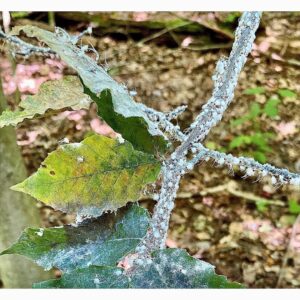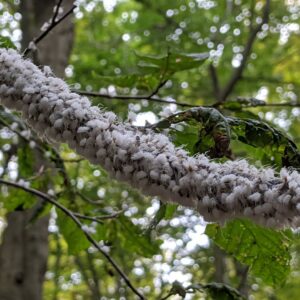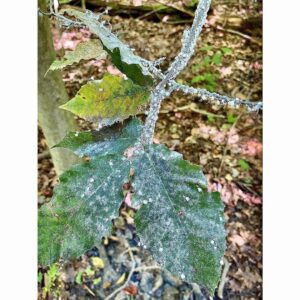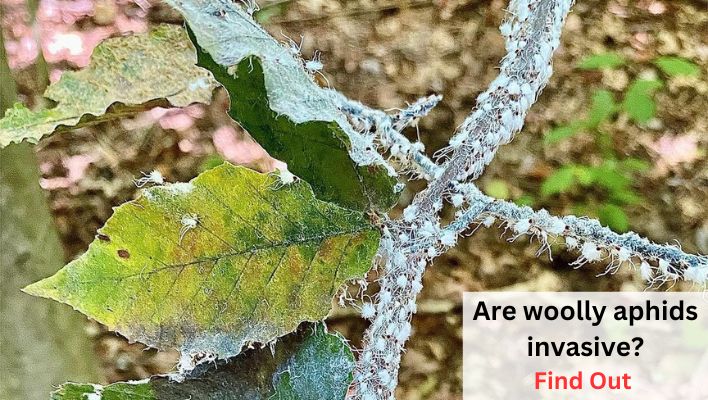What exactly are woolly aphids, and how do they fit into the context of invasiveness among insects? Let’s explore these questions and uncover the truth behind the invasiveness of these tiny yet troublesome creatures.
Woolly aphids, scientifically known as Eriosomatinae, are a type of small insect that falls under the aphid family. These pests are named after the waxy, wool-like substance they produce, which covers their bodies and provides them with protection against predators and environmental conditions. But what sets them apart from other aphids is their invasiveness.
When we talk about invasiveness in the insect world, we’re referring to the ability of a particular species to spread aggressively and cause harm to the ecosystems it invades.
Invasive species often outcompete native species for resources, disrupt the ecological balance, and pose a threat to agriculture, horticulture, and the environment as a whole.
Now, let’s delve deeper into the characteristics of woolly aphids and understand their role in the realm of invasiveness.
What are woolly aphids?
Woolly aphids, also known as Eriosomatinae, are a distinct group of aphids that display unique characteristics in terms of both appearance and behavior.
These tiny insects, typically measuring a few millimeters in length, can be found infesting various plants and trees.
One of the defining features of woolly aphids is the fluffy, wool-like substance that covers their bodies. This white or grayish wax secretion serves as a protective layer against predators, extreme temperatures, and moisture loss. It gives them a distinct appearance, making them easily recognizable.
In terms of behavior, woolly aphids exhibit some interesting traits. They have a complex life cycle, which includes multiple stages such as eggs, nymphs, and adults.

Unlike many other aphids, woolly aphids can reproduce asexually, meaning that females can give birth to live nymphs without the need for mating.
This asexual reproduction contributes to their population growth and potential for rapid colonization.
Several species of woolly aphids are commonly encountered. One such species is the woolly apple aphid (Eriosoma lanigerum), which infests apple trees and can cause significant damage to both the fruit and the tree itself.
Other common species include the woolly elm aphid (Eriosoma americanum), affecting elm trees, and the woolly beech aphid (Phyllaphis fagi), found on beech trees.
Impact of Woolly Aphids
Damage to plants and trees:
Woolly aphids can wreak havoc on plants and trees, causing significant damage to their overall health and appearance.
These pests feed on the sap of their host plants by piercing their delicate tissues with their needle-like mouthparts. This feeding behavior weakens the plants and inhibits their growth.
As woolly aphids continue to extract sap, the affected plants may exhibit various symptoms of distress. Leaves may become distorted, curl, or develop yellowing patches.
Stunted growth and reduced vigor are also common signs of infestation. In severe cases, the infested plants may experience premature leaf drop or even die.
Some species of woolly aphids target specific types of plants. For instance, the woolly apple aphid primarily infests apple trees, causing damage to both the leaves and the fruits.
The presence of these pests can lead to deformed and blemished apples, reducing their market value and overall quality.
Economic consequences:
The economic consequences of woolly aphid infestations can be substantial, particularly in agricultural and horticultural sectors.
Fruit farmers and orchard owners, in particular, bear the brunt of these pests’ impact. Woolly aphids, such as the woolly apple aphid, can significantly reduce fruit yields and compromise their quality.
Moreover, efforts to control and manage woolly aphids can result in additional financial burdens. Farmers may need to invest in insecticides or implement integrated pest management strategies to mitigate the infestation.
These control measures require both time and money, adding to the overall cost of production. The economic impact extends beyond the agricultural realm.
Urban landscapes, public parks, and gardens can also suffer from woolly aphid infestations, affecting the aesthetic appeal and value of these areas.
As we can see, the impact of woolly aphids goes beyond mere cosmetic damage, carrying significant economic consequences for those whose livelihoods depend on the health and productivity of plants and trees.
Are woolly aphids invasive?
To understand whether woolly aphids are invasive, let’s first clarify the definition of invasive species. Invasive species are non-native organisms that are introduced to an ecosystem and have the potential to cause harm to the environment, economy, or human health.
These species often exhibit rapid population growth, competitive advantages, and the ability to spread beyond their original range. When it comes to woolly aphids, their invasive potential varies depending on several factors.
While woolly aphids are not considered invasive on a global scale, they can be invasive in certain regions or ecosystems where they are introduced outside their natural range. In such cases, they can become problematic and pose a threat to local plants and ecosystems.

Several factors contribute to the invasiveness of woolly aphids. One key factor is their ability to reproduce rapidly and produce large populations in a short period.
The asexual reproduction capabilities of woolly aphids allow them to multiply quickly, increasing the chances of establishing thriving colonies and spreading to new areas.
Furthermore, the protective wax covering their bodies provides woolly aphids with an advantage, enabling them to survive various environmental conditions and resist certain control measures.
This resilience contributes to their ability to colonize new habitats and expand their range. Human activities also play a role in the potential invasiveness of woolly aphids.
International trade and the movement of infested plant material can inadvertently introduce these pests to new regions. Once established in a non-native habitat, woolly aphids can disrupt the local ecosystem and negatively impact native plants.
It’s important to note that the invasiveness of woolly aphids can vary depending on the specific species and the susceptibility of the local flora.
Monitoring and early detection of these pests are crucial in managing their potential invasiveness and preventing further spread.
Distribution of Woolly Aphids
Woolly aphids have a diverse distribution, with both native and invasive regions around the world. Understanding the distribution of these pests is essential in assessing their potential invasiveness and implementing effective control measures.
Native and invasive regions:
Woolly aphids are native to certain parts of the world, including Europe, North America, and Asia. In these regions, they are part of the natural ecosystems and have coevolved with their native host plants and natural predators, maintaining a balance in the ecological system.
However, woolly aphids have also been introduced to new regions beyond their native range. In these non-native regions, they can exhibit invasive behavior, causing disruptions to the local flora and posing challenges for agriculture and horticulture.
Factors contributing to invasiveness:
Several factors contribute to the invasiveness of woolly aphids in non-native regions. One significant factor is the absence or lack of natural predators and control mechanisms that would normally keep their populations in check in their native habitats.
Without these natural checks and balances, woolly aphids can rapidly reproduce and establish large populations, leading to widespread infestations.
The lack of natural predators in non-native regions can be attributed to the absence of coevolutionary relationships between the woolly aphids and the local ecosystem.
Native predators and parasites may not recognize or efficiently target these non-native pests, giving them a competitive advantage and allowing them to flourish.
Human activities, such as international trade and transportation of infested plant material, also contribute to the spread of woolly aphids to new regions.

Infested plant material, including nursery stock or untreated wooden packaging materials, can inadvertently carry woolly aphids or their eggs to distant locations.
It’s important to monitor the distribution and movement of woolly aphids to identify areas of concern and take appropriate preventive measures.
Early detection and timely action can help mitigate the invasiveness of woolly aphids and protect vulnerable ecosystems.
How to Get Rid of Woolly Aphids: Effective Control Methods
Dealing with woolly aphids can be a challenging task, but there are several control methods available to manage and eliminate these pests. Let’s explore various ways to control woolly aphids and effectively get rid of them:
Pruning and Removing Infested Plant Parts:
- Inspect plants regularly and prune off heavily infested branches or plant parts.
- Dispose of the infested material properly to prevent the spread of woolly aphids.
Horticultural Oils and Insecticidal Soaps:
- Apply horticultural oils or insecticidal soaps according to the product instructions.
- These products suffocate the pests and disrupt their cell membranes, effectively controlling woolly aphids.
Biological Control:
- Encourage natural predators and parasites that feed on woolly aphids, such as ladybugs, lacewings, and parasitic wasps.
- Introducing these beneficial insects can help keep the aphid population in check.
Neem Oil:
- Neem oil is a natural pesticide derived from the neem tree.
- Dilute neem oil according to the instructions and apply it to affected plants.
- Neem oil disrupts the feeding and reproduction of woolly aphids.
Cultural Practices:
- Maintain plant health through proper watering, fertilization, and pruning.
- Healthy plants are better equipped to withstand aphid infestations.
- Avoid over-fertilization, as excessive nitrogen can promote aphid populations.
Physical Removal:
- Use a strong jet of water to dislodge woolly aphids from plants.
- Repeat this process regularly to control their population.
Reflective Mulches and Barrier Bands:
- Reflective mulches or sticky barrier bands placed around tree trunks can deter woolly aphids from climbing up to infest the plant.
Quarantine and Prevention:
- Inspect new plants or plant material before introducing them to your garden.
- Quarantine new additions for a period to ensure they are free from woolly aphids or other pests.
Beneficial Nematodes:
- Beneficial nematodes, such as Steinernema feltiae, can be applied to the soil.
- These microscopic organisms attack and kill woolly aphid larvae in the soil, helping to reduce their population.
Companion Planting:
- Planting certain companion plants, such as garlic, chives, or marigolds, near-infested plants can help repel woolly aphids.
- The strong scents and natural compounds emitted by these plants act as deterrents.
High-Pressure Water Spray:
- Use a high-pressure water spray to physically dislodge woolly aphids from plants.
- Aim the spray directly at the affected areas to remove and control the aphids.
Organic Homemade Remedies:
- Create homemade sprays using ingredients like garlic, onion, or hot pepper mixed with water.
- These sprays can be effective in repelling or controlling woolly aphids when applied to infested plants.
Reflective Tape or Foil:
- Hang reflective tape or foil strips near plants to create flashes of light that deter woolly aphids.
- The movement and reflection of light can disrupt their feeding and cause them to seek other locations.
Insect Exclusion Netting:
- Cover susceptible plants with fine mesh or insect exclusion netting to physically prevent woolly aphids from reaching them.
- This method creates a physical barrier, effectively protecting plants from infestation.
Cultural Timing:
- Prune or treat plants during their dormant season or in early spring before new growth emerges.
- By targeting the aphids at their vulnerable stages, you can achieve better control.
Integrated Pest Management (IPM):
- Implement an IPM approach, combining multiple strategies such as monitoring, cultural practices, biological control, and targeted insecticide use.
- This comprehensive approach minimizes reliance on chemical treatments and emphasizes long-term management.
Best pesticides to get rid of woolly aphids
When it comes to tackling woolly aphids, using systemic insecticides can be an effective approach.
These pesticides are designed to be absorbed by plants and transported throughout their tissues, providing long-lasting protection against aphid infestations.
Here are three top pesticide brands known for their effectiveness in combating woolly aphids:
Bayer Advanced Tree and Shrub Insect Control:
Bayer is a renowned name in the world of pest control, and their Advanced Tree and Shrub Insect Control product is highly recommended for controlling woolly aphids.
This systemic insecticide is specifically formulated to protect trees and shrubs from a wide range of pests, including woolly aphids.

It can be easily applied to the soil or around the base of the affected plants, ensuring that the active ingredients are taken up by the plant’s vascular system and distributed throughout.
Ortho Tree and Shrub Insect Control Plus Miracle-Gro Plant Food:
Ortho is another trusted brand that offers a systemic insecticide solution for woolly aphid control.
Their Tree and Shrub Insect Control Plus Miracle-Gro Plant Food is a unique combination that not only protects against pests but also provides essential nutrients for the plants.

This product is applied around the base of trees and shrubs, and its systemic action helps in eradicating woolly aphids while promoting healthy plant growth.
Bonide Systemic Insect Control:
Bonide Systemic Insect Control is a highly regarded brand known for its effective control of a wide range of insects, including woolly aphids.
This systemic insecticide is absorbed by the plants and translocated to various parts, making it an ideal choice for combating aphid infestations.

It can be used on ornamental plants, trees, and shrubs, offering long-lasting protection against woolly aphids and other destructive pests.
How to prevent woolly aphids
Preventing the spread of woolly aphids to other plants is crucial to avoid further infestations. Here are some preventive measures you can take:
- Regular inspection: Conduct frequent inspections of your plants, particularly those that are susceptible to woolly aphids. Early detection allows for prompt action and prevents the pests from spreading.
- Isolation and quarantine: If you discover woolly aphids on a plant, isolate them from other plants to prevent their movement. Quarantine new plants before introducing them to your garden or orchard, examining them closely for any signs of infestation.
- Cleaning tools and equipment: Clean gardening tools, such as pruning shears, between uses, especially when moving from an infested plant to a healthy one. This prevents the accidental transfer of woolly aphids.
- Minimize stress on plants: Maintain the overall health and vigor of your plants through proper watering, fertilization, and disease control. Healthy plants are more resilient to pests and less likely to attract woolly aphids.
- Remove and dispose of infested plant material: Prune and remove heavily infested branches or plant parts promptly. Properly dispose of the infested material to prevent the aphids from spreading to other plants.
- Physical barriers: Use physical barriers like insect exclusion netting to prevent woolly aphids from accessing susceptible plants. This can be particularly useful in orchards or areas with a history of infestations.
By implementing these preventive measures, you can significantly reduce the risk of woolly aphids spreading to other plants and help maintain a healthier garden or orchard environment.
Are Woolly Aphids Invasive FAQs
What plants are most susceptible to woolly aphid infestations?
A: Woolly aphids can infest a variety of plants, but certain species are more commonly targeted. Apple trees are highly susceptible to infestations by the woolly apple aphid.
Other common host plants include elm trees, beech trees, pear trees, hawthorn, cotoneaster, and rose bushes.
However, woolly aphids have been known to infest a wide range of ornamental plants and fruit trees, so vigilance is necessary to protect susceptible plants.
Are there any natural predators of woolly aphids?
Yes, there are natural predators and parasites that feed on woolly aphids and can help keep their populations in check. Ladybugs (lady beetles) are known to be voracious consumers of aphids, including woolly aphids.
Lacewings, syrphid flies (hoverflies), and certain parasitic wasps also prey on woolly aphids. By promoting a diverse and balanced ecosystem in your garden or orchard, you can encourage these beneficial insects to naturally control woolly aphid populations.

Can woolly aphids survive in cold climates?
Woolly aphids have developed adaptations that enable them to survive in various climates, including colder regions.
While their activity may decrease during winter, woolly aphids can endure cold temperatures by seeking sheltered areas or overwintering in their egg stage.
The waxy coating on their bodies provides some protection against freezing temperatures. However, extremely harsh or prolonged cold spells can still have a detrimental effect on their survival rates.
Additionally, some species of woolly aphids may have different cold tolerance levels, with some being more adapted to cold climates than others.
Are woolly aphids resistant to pesticides?
A: Woolly aphids can exhibit varying levels of resistance to certain pesticides, particularly when over-reliance on a single pesticide has occurred over time.
Continuous use of the same chemical can lead to the development of resistance in aphid populations. The waxy protective coating on woolly aphids can also make it more challenging for pesticides to penetrate and effectively control them.
However, it’s important to note that the susceptibility of woolly aphids to pesticides can vary depending on the specific chemical used and the aphid population in question.
It is recommended to rotate between different classes of pesticides and use integrated pest management (IPM) approaches that include multiple control methods to minimize the risk of resistance and effectively manage woolly aphid infestations.
Conclusion
Woolly aphids can pose significant challenges to plants and trees, causing damage and economic consequences.
These pests, characterized by their fuzzy appearance and sap-sucking behavior, can infest a wide range of plants, with certain species being particularly susceptible.
Their ability to reproduce quickly and establish large populations makes them a concern for gardeners, farmers, and horticulturists.
While woolly aphids are native to certain regions, they can also exhibit invasive behavior when introduced to non-native areas.
Factors such as the absence of natural predators and the unintentional human-assisted transportation of infested plant material contribute to their invasiveness.
Understanding their distribution, both native and invasive, is crucial for implementing effective management and control strategies.
By being proactive, vigilant, and employing a combination of control strategies, it is possible to manage and control woolly aphids effectively.
Early detection, regular monitoring, and a comprehensive understanding of their behavior and habitat are key to mitigating their impact and protecting plant health.
